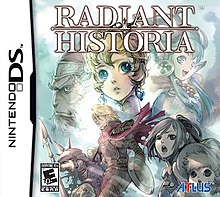| Radiant Historia | |
|---|---|
 North American Nintendo DS box art | |
| Developer(s) | Atlus Headlock |
| Publisher(s) |
|
| Director(s) | Mitsuru Hirata Satoshi Takayashiki |
| Designer(s) | Tomohiro Okuno Yasuko Sumiya Satoshi Takayashiki |
| Programmer(s) | Daisuke Yajima |
| Artist(s) | Hiroshi Konishi Masaki Hirooka (3DS) |
| Writer(s) | Yoh Haduki Souzou Tonami Kazuhito Okayama |
| Composer(s) | Yoko Shimomura |
| Platform(s) | Nintendo DS Nintendo 3DS |
| Release | Nintendo DSNintendo 3DS |
| Genre(s) | Role-playing |
| Mode(s) | Single-player |
Radiant Historia[a] is a role-playing video game co-developed by Atlus and Headlock for the Nintendo DS. It was released in Japan in 2010 by Atlus, and in North America in 2011 by their subsidiary Atlus USA. An expanded remake for the Nintendo 3DS, titled Radiant Historia: Perfect Chronology, was released in 2017 in Japan and released in North America and PAL territories the following year, with the latter version being published by Deep Silver.
The game is set on Vainqueur, a continent divided between the warring nations of Alistel and Granorg. Alistel soldier Stocke is chosen to wield the White Chronicle, a tome capable of navigating multiple timelines, so he may prevent Vainqueur's desertification. Stocke and his party explore Vainqueur, fighting enemies on a grid-based battlefield using a turn-based system. Travelling between alternate timelines is a key part of both the storyline and the gameplay, with the number of potential timelines unlocked influencing the ending.
Radiant Historia was developed by a team with staff drawn from both Atlus' Megami Tensei series, and the tri-Ace title Radiata Stories. First proposed by Satoshi Takayashiki in 2007, the base concept underwent several changes due to suggestions from Atlus staff. The remake included redrawn artwork, voice acting, an additional story path, and an animated opening produced by A-1 Pictures. The music for both versions was composed by Yoko Shimomura, with theme songs performed by Haruka Shimotsuki.
Reception and sales for both versions have been positive, with both reaching high sales chart positions in Japan and the West. The original received praise for its gameplay and time travel mechanics, though opinions were mixed on its graphics and linear structure. Several critics compared it favourably to role-playing games from the 16-bit gaming era. The remake saw a generally positive response, with many praising the added story and gameplay content.
Cite error: There are <ref group=lower-alpha> tags or {{efn}} templates on this page, but the references will not show without a {{reflist|group=lower-alpha}} template or {{notelist}} template (see the help page).